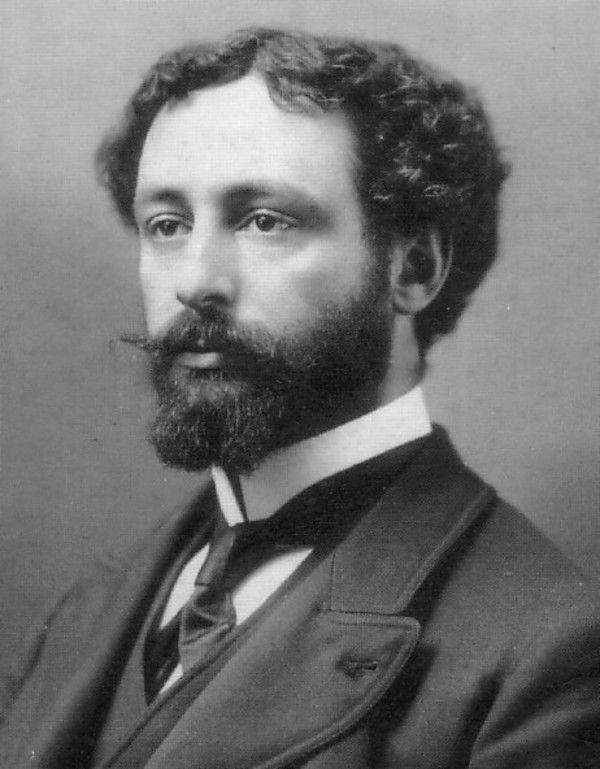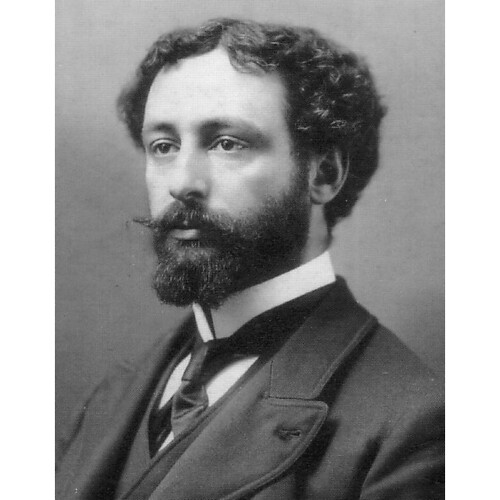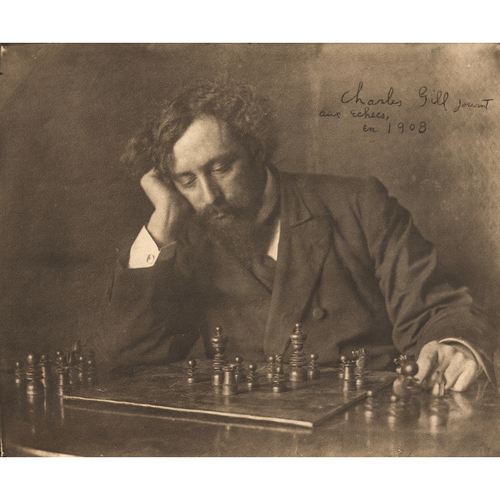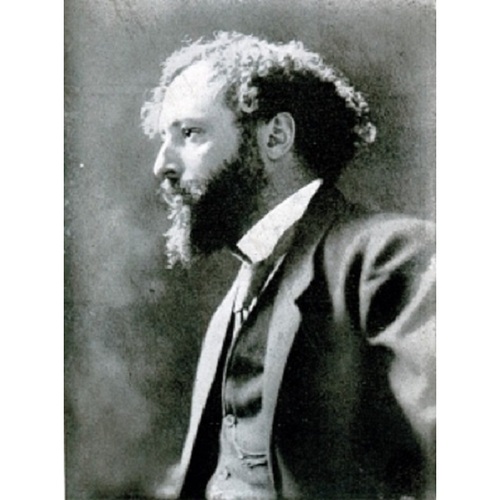
Source: Courtesy of Wikimedia Commons
GILL, CHARLES (baptized Charles-Ignace-Adélard), painter, poet, storyteller, and art teacher; b. 21 Oct. 1871 in Sorel, Que., son of Charles-Ignace Gill, a lawyer, mla, and eminent jurist, and Delphine (Delphire) Senécal; m. 12 May 1902 Georgine Bélanger* (d. 1951) in Montreal, and they had two sons, only one of whom reached adulthood; d. 16 Oct. 1918 in Montreal.
Charles Gill was the grandson of Louis-Adélard Senécal*, a prominent businessman and politician from the Richelieu region, and of Ignace Gill*, a merchant and mla for Yamaska. He was also related to Samuel Gill, who had been kidnapped by the Abenaki at the age of nine in Salisbury, Mass., on 10 June 1697 and brought to Saint-François-de-Sales (Odanak), in New France.
Gill was not overly diligent at elementary and secondary school; his marks were mediocre, his failures many. From September 1882 until the spring of 1885 he studied at the Collège Sainte-Marie (elements of French and Latin). In September 1885 he was in second form (Syntax) at the Séminaire de Nicolet. In February 1887 he was in third form (Method) at the Collège de Saint-Laurent, an institution he left in the spring of 1888. His parents, who had been living in Montreal since April 1886, sent him to study privately with Adrien Leblond de Brumath in March 1888.
An important event in Gill’s life occurred in the summer of 1888. George de Forest Brush, an American painter who was vacationing in Pierreville, undertook to ensure that the young man, who was still in search of his true vocation, could develop his talent for painting. As a result, Charles went to the Art Association of Montreal that September to study with William Brymner*. What had been thought simply a penchant for drawing suddenly became a compelling need to create. “From childhood,” wrote Joseph-Marie Melançon* in Le Devoir on 14 Oct. 1933, “the future artist exhibited to the world a rich nature, full of witticisms, but complex and difficult to shape. He was a strange, enigmatic boy who, [shunning] the games for his age, preferred slipping away to the Indian reserve on the Rivière Saint-François, near Pierreville, his grandparents’ estate, in order to draw the faces of the Abenaki. By seven – a precocious talent! – he was already skilful at handling a pencil.”
To make his dream come true, Gill embarked for France on 6 Sept. 1890. He studied in Paris with the painter Léon Gérôme and did not return to Montreal until June 1892. In October he left again for Paris and he came back to Canada for good in the spring of 1894. His visits to Paris had given him the chance to audit classes, which enabled him to develop his ideas about art in the broadest sense. He had taken an interest in painting but had also gone to the theatre, contemplated the impressive architecture of churches and other great buildings, and associated with poets. On his return from France he boasted of having been privileged to know Paul Verlaine and François Coppée. Sometimes he had jokingly pretended to be Jean Richepin because of his striking resemblance to the poet. He had felt free in the City of Light and in his unconventional way tasted the glories and woes to which Charles Baudelaire’s Fleurs du mal alludes. He painted a number of canvases, exhibited his work on several occasions in Montreal, and organized his own atelier, first at 946 Rue Saint-Denis and later at 42 Rue Chambord.
From then on, painting and poetry would equally preoccupy him. On 21 May 1896 he became a member of the École Littéraire de Montréal, whose meetings reminded him of those of La Boucane, at the Café du Rocher on the Boulevard Saint-Germain in Paris, where the “Canadian exiles” used to gather. He developed along with the École Littéraire de Montreal, learning the art of journalism from Louvigny de Montigny*, poetry from Émile Nelligan* and Albert Lozeau*, and storytelling from Louis Fréchette* and Albert Laberge*. He participated to the full in the joys of the circle’s public sessions and proved a competitor to be reckoned with in its internal quarrels and struggles. In 1912 he became the group’s president. To have a steady income, he taught drawing at the École Normale Jacques-Cartier, painted canvases, and wrote poems, stories, and articles, sometimes using the pseudonyms Léon Duval and Clairon.
On 12 May 1902 Gill married Georgine Bélanger, a journalist, columnist for La Presse, and novelist who was quite well known under her pseudonym of Gaétane de Montreuil. In April 1903 they had a son who died shortly after birth. A second son, Roger-Charles, was born on 7 Dec. 1904. The couple’s relationship was strained, however, because of Gill’s unconventional way of life, which was marked by all kinds of turbulent events. Since the summer of 1897, also, he had been having an affair with Juliette Boyer, a close friend who was also his model. He and Georgine finally decided to separate on 24 Oct. 1913. Gill had problems with his health during the last five years of his life, but he pursued his dream of painting nature in the Saguenay area more and more realistically, and of completing his “Dantesque epic,” whose concept and image in some sense grew out of the legend, history, and magnificent landscape of his native land. His favourite words were “Eternity,” “Nothingness,” and “Abyss,” which all turn on the multiple meanings of the Greek term ananke. Gill succumbed to the Spanish influenza on 16 Oct. 1918, after a week’s illness.
It is difficult to enumerate Gill’s pictorial output, which began at Pierreville during the 1880s and continued until his death. Reduced to the bare essentials, it consists of some 50 portraits, about 100 landscapes, and a number of studies, outlines, and copies, as well as three notebooks of sketches dating from 1889 and 1890. Several canvases show genuine talent: Le problème d’échecs, Le portrait de madame Charles Gill, Le cap Éternité, Crépuscule à Chambly, and Ormes au ciel rose. Two geographical areas that appear frequently in Gill’s pictorial universe are Pierreville-Odanak and the Saguenay; trees often form part of the landscape and Cap Éternité figures prominently. As a rule, a strong touch predominates over nuances.
Réginald Hamel, the recognized expert on Gill’s life and work, has drawn up an inventory of the Sorel artist’s literary output from 1896 to 1918. It includes 58 poems, 95 prose texts, and 13 fragments of an epic poem, “Le Saint-Laurent.” Two hundred and sixty-seven letters penned during the years 1890–1918, largely to the poet Louis-Joseph Doucet*, have also been discovered. Gill’s interest in prose – short stories, newspaper columns, satirical narratives, and “daily impressions” – is noteworthy. He also published critical studies of poets and painters. His prose writings appeared mainly in La Patrie, La Presse, Les Débats, Le Canada, and Le Nationaliste, all published in Montreal.
Gill had long thought of producing a collection of poetry in the style of Baudelaire, to be entitled “Les étoiles filantes.” He had written several dozen poems, but when the time came for the final selection, his sister Rachel imposed such strict censorship that only 32 “suitable” pieces were left. Gill’s master-work was to have been “Le Saint-Laurent,” fragments of which were published in 1919, after the poet’s death, under the title “Le cap Éternité”. The final version of this poem is believed to have been lost shortly before he died; a few existing outlines, however, make it possible to imagine the genesis of the work he had dreamed of. On 31 Jan. 1904 Gill had hastily mapped out, on a large sheet of bluish paper, the plan of his poem, a long work in four parts, “Printemps,” “Été,” “Automne,” “Hiver.” The four seasons held a symbolic meaning and each was to consist of several cantos based on the history and geography of Canada. This scheme was revised in 1908. It would comprise several books, the first being “Le cap Éternité,” a poem in 32 cantos and a prologue. The ninth canto in this book, also entitled “Le cap Éternité,” had been written at L’Anse-Saint-Jean in August 1908, and published in the first issue of Le Terroir (Montréal) in January 1909. It is by far the finest text among his 13 cantos, which included also “Stances aux étoiles.” In the latter piece, gazing at the Saguenay in the shadow of the enigmatic Indian Tacouérima, Gill imagines himself drifting along caught up “gloriously in a dream of Dante.” But it was a very real imprint of his own presence that he left on the legendary St Lawrence.
[Charles Gill’s published literary output consists of two posthumously issued volumes, “Le cap Éternité, poème suivi des “Étoiles filantes” (Montréal, 1919) and Correspondance, Réginald Hamel, édit. (Montréal, 1969). Gill’s manuscript writings are now accessible thanks to the work of Réginald Hamel, who has brought together, classified, and annotated the “Œuvres complètes,” based on the original texts. The sole copy of his compilation, consisting of four typescript volumes (Montréal, 1958–59), is deposited at the Centre de Documentation des Lettres Canadiennes-Françaises at the Univ. de Montréal. Hamel has also examined Gill’s poem “Le Saint-Laurent” in his thesis, “‘Le Saint-Laurent’ de Charles Gill: genèse, établissement du texte, valeur littéraire” (thèse de ma, univ. d’Ottawa, 1961).
Gill’s pictorial output is more difficult to locate. The majority of his works are in private collections, but the Musée du Québec (Québec) holds seven of his paintings. p.w.]. AC, Montréal, État civil, Catholiques, Saint-Jacques (Montréal), 12 mai 1902. ANQ-M, CE3-7, 22 oct. 1871. Réginald Hamel, “Un Canayen à Paris (Charles Gill),” Le Devoir, 30 oct. 1965: 23–24. DOLQ, vol.2. Lucien Gagné, “Charles Gill,” L’Action nationale (Montréal), 29 (1947): 361–85. Réginald Hamel, “Charles Gill, prosateur,” in L’École littéraire de Montréal; bilan littéraire de l’année 1961, sous la direction de Paul Wyczynski et al. (2e éd., Montréal, 1972), 178–200. Hamel et al., DALFNA, 605–6. Olivier Maurault, “Charles Gill, peintre et poète,” Rev. canadienne (Montréal), 87 (juill.–déc. 1919): 18–31, 180–97. Albert Savignac, “‘Le cap Éternité,’ poème par Charles Gill,” La Rev. nationale (Montréal), 1 (1919): 297–309. [Paul Wyczynski], Albert Laberge, 1871–1960; Charles Gill, 1871–1918 (exhibition catalogue, National Library of Canada, Ottawa, 1971); “Charles Gill intime,” Rev. de l’univ. d’Ottawa, 29 (1959): 447–72; “Étude d’auteur canadien: Charles Gill,” Lectures (Montréal), nouv. sér., 7 (1960–61): 163–65.
Cite This Article
Paul Wyczynski, “GILL, CHARLES (baptized Charles-Ignace-Adélard),” in Dictionary of Canadian Biography, vol. 14, University of Toronto/Université Laval, 2003–, accessed January 16, 2026, https://www.biographi.ca/en/bio/gill_charles_14E.html.
The citation above shows the format for footnotes and endnotes according to the Chicago manual of style (16th edition). Information to be used in other citation formats:
| Permalink: | https://www.biographi.ca/en/bio/gill_charles_14E.html |
| Author of Article: | Paul Wyczynski |
| Title of Article: | GILL, CHARLES (baptized Charles-Ignace-Adélard) |
| Publication Name: | Dictionary of Canadian Biography, vol. 14 |
| Publisher: | University of Toronto/Université Laval |
| Year of publication: | 1998 |
| Year of revision: | 1998 |
| Access Date: | January 16, 2026 |





